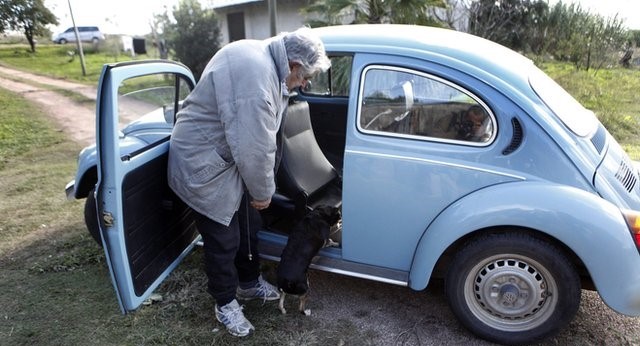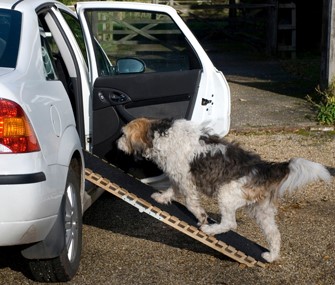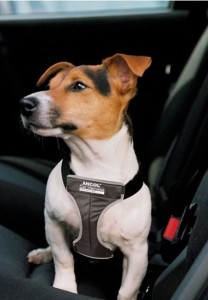One of my favourite things to do in the world is jump in the car with Charlie and head to a park or the beach for some off lead fun. As soon as I open the car door Charlie hops into the back seat, gets buckled in and then settles down for the journey knowing we are destined for somewhere exciting.
However, this was not always the case. When I first adopted Charlie over five years ago he hated the car as it was associated with going to the vets for physiotherapy on his leg, which he loathed! This meant I had to physically pick him up (all 30kg of him!) and place him trembling in the back seat, once in the car he would shut down with eyes bulging and rapid panting, which you can imagine was pretty distressing for both of us.
Once his vet visits had ended I was determined that we would work on a program so I could help him feel happier about getting in the car so we could start our adventures together…
Helping a fearful dog feel happy about travelling in a car
 The behaviour plan outlined below is designed for a dog that would sit in the back seat of a car.
The behaviour plan outlined below is designed for a dog that would sit in the back seat of a car.
If you wish to have your dog sit in the boot that is ok too but it is important to always make sure the parcel shelf is removed and they are safely secured in this area either with a dog guard or if suitable a car harness and attachment. A closed boot is a scary place (think of all those thriller movies) and it is also very close to the exhaust which for a dog’s super powerful nose is incredible nauseating, so if you cannot remove a parcel shelf in your car the boot is not a suitable place for them to travel.
If your dog is worried about other elements outside – such as passing traffic, other dogs etc. if possible reverse your car into your driveway so they are nice and close to the safety of the house should they need a break. Ideally you want to be able to give them enough space so they can move towards the car and equally move away again at their own pace but of course this will be dependent on the amount of space you have in your particular situation.
As we know working with a nervous dog takes time, consistency and a great deal of patience and understanding. It is important never to force your dog into a situation where they are showing signs of fear or discomfort. Your dog, with your guidance, needs to make up their own mind up about how much they can manage in one session. This feeling of having some control over their situation facilitates much quicker learning and for nervous dogs is essential for building confidence.
Setting up the car
- Open up all the door so your dog can clearly see through the car to the other side.
- Keep the temperature off so it doesn’t get overly warm and it remains quiet.
- Avoid turning on the radio.
- Avoid using air fresheners or polish in the car immediately before training.
- It can help to have your dog’s blanket or a piece of your clothing in the car also.
 It might also be an idea to “scent the car” for your dog before starting the exercise to encourage them to investigate the thing they have to date been worried by – you can use food, essential oils, dog hair from their grooming brush, plastic soup container etc the list is endless! This opportunity to perform a naturally rewarding behaviour will help to lower anxiety and give them something other than “getting into the scary car” to focus on before the training begins.
It might also be an idea to “scent the car” for your dog before starting the exercise to encourage them to investigate the thing they have to date been worried by – you can use food, essential oils, dog hair from their grooming brush, plastic soup container etc the list is endless! This opportunity to perform a naturally rewarding behaviour will help to lower anxiety and give them something other than “getting into the scary car” to focus on before the training begins.
Before you start prepare some pea sized pieces of chopped up meat or cheese or carrots – depending on what you dogs favourite thing in the world is! Only give these treats for this type of training, don’t be tempted to give your dog these at any other time as it is important that they retain their high value status. If your dog isn’t a big foody and prefers fuss or a toy you can use these things as a reward instead.
Remember though to really strengthen behaviours we must heavily reinforce them – i.e. so don’t be afraid to pay out – if your dog loves when you squeak and jump up and down – do it!
Now you have the car set up – if your dog gets geed up when you put on their harness and lead play a game in the back garden or practice some of their well-established cues – sit, paw, down etc to help break the association of harness going on means a walk as you don’t want them to be distracted or equally feel tricked as you could inadvertently end up creating a negative association with their walking gear. Once they have burned off some steam allow them to cool down before starting your training with the car.
Ok so now your car and dog are all set up for training.
Let’s start training
On a loose lead (ideally one that is 5-6ft in length) walk calmly and confidently towards the car. Try to be aware of your own body language so not to have your dog pick up on any apprehensive signals you may be giving off, as when we anticipate failure, unfortunately that is what we usually get.
Be conscious not to “pull” your dog towards the car and try to keep the leash slack at all times.
If they stop, wait a few seconds and give them a chance to move forward – if they do, treat immediately and give lots of fuss & repeat as you move towards the car one step at a time
Note: when we are asking for a behaviour we want to try to avoid luring our dogs forward with food i.e. holding a piece of food in front of their face always slightly out of reach – as this does not allow for true learning & is often effectively tricking our dogs into doing something they do not wish to do – also the downside of this is it also only usually works the once.
If they don’t move forward or if they begin to back up – go back a few steps until they show a relaxed response. Depending on the severity of the anxiety your dog feels around the car this could be quiet a distance – that’s ok. Once your dog appears relaxed, take one step towards the car – immediately treat and fuss if they move with you.

Build this up until your dog is immediately beside the car. At this point you will need to work out what suits you and your dog best – either you getting into the car and rewarding them for hoping in beside you (usually the easier option) or standing outside and patting the seat and encouraging them to hop in. You may need to break this step down into mini steps and rewards at each stage – for example – your dog put their nose on the seat, immediately treat and fuss, they put a paw on the seat, immediately treat and fuss and so on.
 Note: It is important to be aware of your own dogs mobility – can they easily jump in and out of the car and if not why not? If you have any concerns about their being any pain or discomfort please consult your vet before carrying out any training program. If your dog has been diagnosed with a medical issue that affects their ease of movement it may be worthwhile looking at getting a dog ramp. You will need to teach them how to use this first on a flat surface, gradually building up to asking them to walk up it into the car.
Note: It is important to be aware of your own dogs mobility – can they easily jump in and out of the car and if not why not? If you have any concerns about their being any pain or discomfort please consult your vet before carrying out any training program. If your dog has been diagnosed with a medical issue that affects their ease of movement it may be worthwhile looking at getting a dog ramp. You will need to teach them how to use this first on a flat surface, gradually building up to asking them to walk up it into the car.
Once your dog is happily stepping in and out of the car you can start to look at building duration – if they know cues such as sit, paw, down etc you can ask them to perform these while inside the vehicle.
This will also give you a good measure about how your dog is feeling as stressed dogs generally won’t respond even to well-practiced cues.
If your dog is happy to relax in the back seat with you, start closing one of the door. Once they are relaxed with this step you can try closing both doors. If they remain happy and relaxed with the doors closed – pat both of you on the back as this is great progress!
I would recommend using a car harness with all dogs that are traveling on the back seat of a car as this ensures that you and they are safe. Let’s face it a loose dog in a car driving down the motorway is a potentially lethal weapon if they decide to climb into the front seat and onto your lap.
So now your dog is happily sitting in the back seat with the doors closed – start to introduce being strapped in with the harness. This step can worry some dogs as they are effectively tied down so take your time with this step – get them used to hearing the noise of the seatbelt clicking and the tension it puts on the harness – lots of treats and fuss.
 Once your dog appears relaxed wearing their harness you can introduce opening one of the doors. Once they appear happy with this step – start moving yourself out of the car and quietly closing the door.
Once your dog appears relaxed wearing their harness you can introduce opening one of the doors. Once they appear happy with this step – start moving yourself out of the car and quietly closing the door.
If they appear worried at any point you may need to break this down into two steps – you exiting – treat and fuss & then closing the door – treat and fuss. Practice closing the door initially to begin with for 1 second gradually building up to longer and longer periods of time, until they appear relaxed and are no longer completely focused on you standing outside.
At this point you are ready to get into the driving seat – remember this is also a step so you want to provide them with lots of fuss and praise if you get a calm response when you sit into the car. Now that your dog is comfortable and everyone is in position you are ready to turn in the engine – don’t be tempted to drive anywhere yet! At this point we are just getting them accustomed to the noises and smells associated with the engine being on while you continue to treat and praise for their calm behaviour.
Next step is to go through the various noises & visuals that your dog will encounter as you drive – wipers going on, indicators, demister and even the car horn. You want all of these things to be established positive noises for your dog so that when you are driving along if they are feeling anxious at all the wipers going on is not the thing that tips them over the edge. Remember to treat and fuss at each step.
You are finally ready to drive….. but only in the driveway! Practice moving the car a few feet in and out of the driveway. Once your dog appears relaxed with this step you can try driving maximum 5 minutes down the road. Try end up somewhere that you can take them out to stretch their legs, play ball, have a cuddle, meet up with a doggy pal etc. As you cannot give a food or toy reward while you are driving you will need to provide lots of verbal praise and this nice “surprise” when the car stops will act as the reinforcer for their bravery in the car.

Note: throughout all of the program remember to give lots of breaks and allow your dog and opportunity to reset and go again. Imagine being asked to do something challenging from your own perspective – if for example you hated maths or science or history at school and I stood in front of you and asked you a question and as soon as you got it right…… I asked you a harder one and then a harder one and then a harder one…. eventually regardless of the payout the stress would become too much and you would not want to work with me anymore.
The same happens with our dogs – we need to ask them a tricky question and then give then either an easy one or offer them a chance to take a break. This way we are facilitating success for both ourselves and our dogs
Remember, this training could be done in half an hour or a month depending on your dog and the severity of their anxiety. Every dog is different as is every situation and experience. With patience and consistency, there is no reason that you can’t all make this work for you and for your dog. Always go at your dog’s pace, if it’s too much too soon, just go back a step and try again tomorrow & the number one rule…. celebrate your triumphs when they happen!
Any questions pop them in the comment section below.
Happy training everyone….. 

